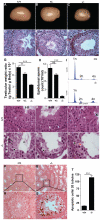Dicer1 depletion in male germ cells leads to infertility due to cumulative meiotic and spermiogenic defects
- PMID: 21998645
- PMCID: PMC3187767
- DOI: 10.1371/journal.pone.0025241
Dicer1 depletion in male germ cells leads to infertility due to cumulative meiotic and spermiogenic defects
Abstract
Background: Spermatogenesis is a complex biological process that requires a highly specialized control of gene expression. In the past decade, small non-coding RNAs have emerged as critical regulators of gene expression both at the transcriptional and post-transcriptional level. DICER1, an RNAse III endonuclease, is essential for the biogenesis of several classes of small RNAs, including microRNAs (miRNAs) and endogenous small interfering RNAs (endo-siRNAs), but is also critical for the degradation of toxic transposable elements. In this study, we investigated to which extent DICER1 is required for germ cell development and the progress of spermatogenesis in mice.
Principal findings: We show that the selective ablation of Dicer1 at the early onset of male germ cell development leads to infertility, due to multiple cumulative defects at the meiotic and post-meiotic stages culminating with the absence of functional spermatozoa. Alterations were observed in the first spermatogenic wave and include delayed progression of spermatocytes to prophase I and increased apoptosis, resulting in a reduced number of round spermatids. The transition from round to mature spermatozoa was also severely affected, since the few spermatozoa formed in mutant animals were immobile and misshapen, exhibiting morphological defects of the head and flagellum. We also found evidence that the expression of transposable elements of the SINE family is up-regulated in Dicer1-depleted spermatocytes.
Conclusions/significance: Our findings indicate that DICER1 is dispensable for spermatogonial stem cell renewal and mitotic proliferation, but is required for germ cell differentiation through the meiotic and haploid phases of spermatogenesis.
Conflict of interest statement
Figures






Similar articles
-
Dicer is required for haploid male germ cell differentiation in mice.PLoS One. 2011;6(9):e24821. doi: 10.1371/journal.pone.0024821. Epub 2011 Sep 16. PLoS One. 2011. PMID: 21949761 Free PMC article.
-
Germ cell-specific targeting of DICER or DGCR8 reveals a novel role for endo-siRNAs in the progression of mammalian spermatogenesis and male fertility.PLoS One. 2014 Sep 22;9(9):e107023. doi: 10.1371/journal.pone.0107023. eCollection 2014. PLoS One. 2014. PMID: 25244517 Free PMC article.
-
Inactivation of Dicer1 has a severe cumulative impact on the formation of mature germ cells in mouse testes.Biochem Biophys Res Commun. 2012 May 25;422(1):114-20. doi: 10.1016/j.bbrc.2012.04.118. Epub 2012 Apr 30. Biochem Biophys Res Commun. 2012. PMID: 22564735
-
The role of Dicer1 in the male reproductive tract.Asian J Androl. 2015 Sep-Oct;17(5):737-41. doi: 10.4103/1008-682X.155542. Asian J Androl. 2015. PMID: 25994652 Free PMC article. Review.
-
Small RNA molecules in the regulation of spermatogenesis.Reproduction. 2009 Jun;137(6):901-11. doi: 10.1530/REP-08-0494. Epub 2009 Mar 24. Reproduction. 2009. PMID: 19318589 Review.
Cited by
-
MicroRNAs 221 and 222 regulate the undifferentiated state in mammalian male germ cells.Development. 2013 Jan 15;140(2):280-90. doi: 10.1242/dev.087403. Epub 2012 Dec 5. Development. 2013. PMID: 23221369 Free PMC article.
-
Role of Dicer1-Dependent Factors in the Paracrine Regulation of Epididymal Gene Expression.PLoS One. 2016 Oct 3;11(10):e0163876. doi: 10.1371/journal.pone.0163876. eCollection 2016. PLoS One. 2016. PMID: 27695046 Free PMC article.
-
The Roles of MicroRNAs in Male Infertility.Int J Mol Sci. 2021 Mar 13;22(6):2910. doi: 10.3390/ijms22062910. Int J Mol Sci. 2021. PMID: 33805594 Free PMC article. Review.
-
Med1 regulates meiotic progression during spermatogenesis in mice.Reproduction. 2015 Jun;149(6):597-604. doi: 10.1530/REP-14-0483. Epub 2015 Mar 16. Reproduction. 2015. PMID: 25778538 Free PMC article.
-
Regulation of mammalian spermatogenesis by miRNAs.Semin Cell Dev Biol. 2022 Jan;121:24-31. doi: 10.1016/j.semcdb.2021.05.009. Epub 2021 May 15. Semin Cell Dev Biol. 2022. PMID: 34006455 Free PMC article. Review.
References
-
- Eddy EM. Male germ cell gene expression. Recent Prog Horm Res. 2002;57:103–128. - PubMed
-
- Kim VN, Han J, Siomi MC. Biogenesis of small RNAs in animals. Nat Rev Mol Cell Biol. 2009;10:126–139. - PubMed
-
- He Z, Kokkinaki M, Pant D, Gallicano GI, Dym M. Small RNA molecules in the regulation of spermatogenesis. Reproduction. 2009;137:901–911. - PubMed
-
- Papaioannou MD, Nef S. microRNAs in the testis: building up male fertility. J Androl. 2010;31:26–33. - PubMed
Publication types
MeSH terms
Substances
LinkOut - more resources
Full Text Sources
Medical
Molecular Biology Databases
Miscellaneous

